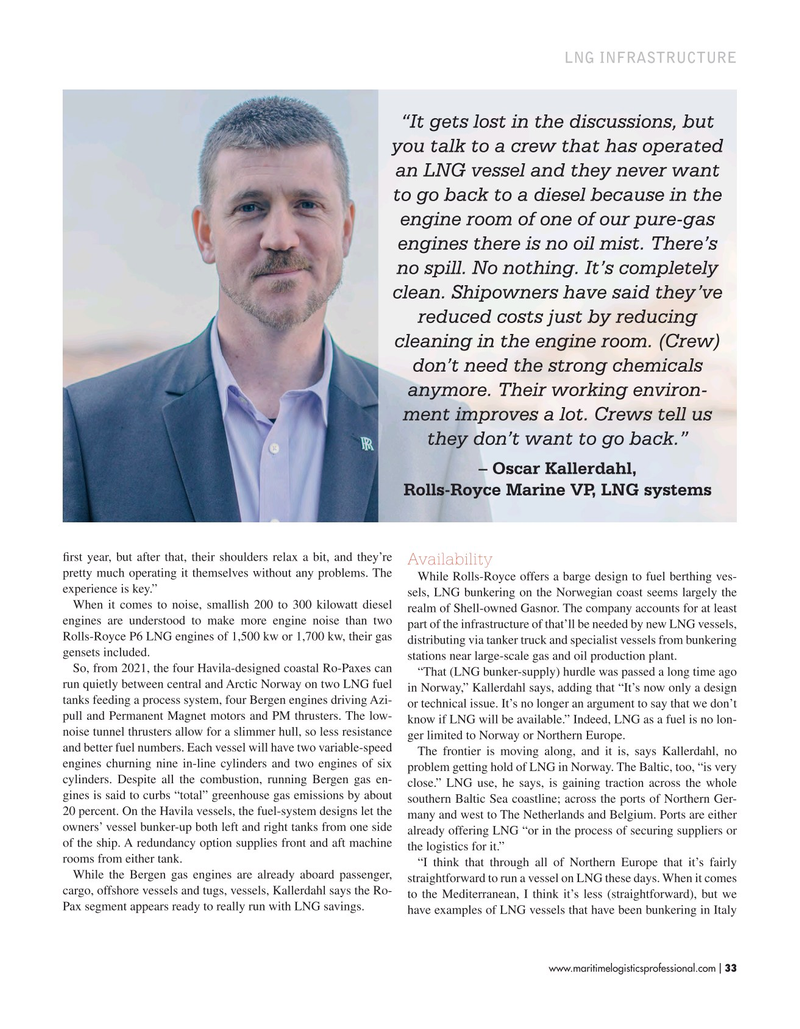
Page 33: of Maritime Logistics Professional Magazine (Nov/Dec 2018)
Regulatory & Environmental Review
Read this page in Pdf, Flash or Html5 edition of Nov/Dec 2018 Maritime Logistics Professional Magazine
LNG INFRASTRUCTURE “It gets lost in the discussions, but you talk to a crew that has operated an LNG vessel and they never want to go back to a diesel because in the engine room of one of our pure-gas engines there is no oil mist. There’s no spill. No nothing. It’s completely clean. Shipowners have said they’ve reduced costs just by reducing cleaning in the engine room. (Crew) don’t need the strong chemicals anymore. Their working environ- ment improves a lot. Crews tell us they don’t want to go back.” – Oscar Kallerdahl,
Rolls-Royce Marine VP, LNG systems frst year, but after that, their shoulders relax a bit, and they’re
Availability pretty much operating it themselves without any problems. The
While Rolls-Royce offers a barge design to fuel berthing ves- experience is key.” sels, LNG bunkering on the Norwegian coast seems largely the
When it comes to noise, smallish 200 to 300 kilowatt diesel realm of Shell-owned Gasnor. The company accounts for at least engines are understood to make more engine noise than two part of the infrastructure of that’ll be needed by new LNG vessels,
Rolls-Royce P6 LNG engines of 1,500 kw or 1,700 kw, their gas distributing via tanker truck and specialist vessels from bunkering gensets included. stations near large-scale gas and oil production plant.
So, from 2021, the four Havila-designed coastal Ro-Paxes can “That (LNG bunker-supply) hurdle was passed a long time ago run quietly between central and Arctic Norway on two LNG fuel in Norway,” Kallerdahl says, adding that “It’s now only a design tanks feeding a process system, four Bergen engines driving Azi- or technical issue. It’s no longer an argument to say that we don’t pull and Permanent Magnet motors and PM thrusters. The low- know if LNG will be available.” Indeed, LNG as a fuel is no lon- noise tunnel thrusters allow for a slimmer hull, so less resistance ger limited to Norway or Northern Europe. and better fuel numbers. Each vessel will have two variable-speed
The frontier is moving along, and it is, says Kallerdahl, no engines churning nine in-line cylinders and two engines of six problem getting hold of LNG in Norway. The Baltic, too, “is very cylinders. Despite all the combustion, running Bergen gas en- close.” LNG use, he says, is gaining traction across the whole gines is said to curbs “total” greenhouse gas emissions by about southern Baltic Sea coastline; across the ports of Northern Ger- 20 percent. On the Havila vessels, the fuel-system designs let the many and west to The Netherlands and Belgium. Ports are either owners’ vessel bunker-up both left and right tanks from one side already offering LNG “or in the process of securing suppliers or of the ship. A redundancy option supplies front and aft machine the logistics for it.” rooms from either tank.
“I think that through all of Northern Europe that it’s fairly
While the Bergen gas engines are already aboard passenger, straightforward to run a vessel on LNG these days. When it comes cargo, offshore vessels and tugs, vessels, Kallerdahl says the Ro- to the Mediterranean, I think it’s less (straightforward), but we
Pax segment appears ready to really run with LNG savings. have examples of LNG vessels that have been bunkering in Italy www.maritimelogisticsprofessional.com 33
I

 32
32

 34
34
